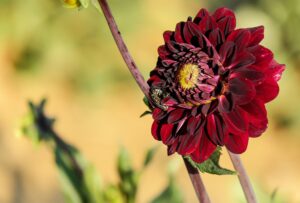The enchanting allure of black color flowers adds a touch of mystery, elegance, and drama to gardens and floral arrangements. While true black flowers are rare in nature, the deep, dark hues of these blooms create a captivating and sophisticated aesthetic.

True black color flowers are uncommon, making them a rarity in the world of flora. The quest for deep, dark blooms has led to the cultivation of varieties that exhibit shades approaching black, such as deep purples, maroons, and velvety dark reds. The presence of black blooms in a garden design adds a touch of drama and sophistication. When strategically placed, these flowers can enhance the overall aesthetic, creating a visually arresting and memorable outdoor space.
Various flowers are celebrated for their dark or nearly black blooms. Examples include the ‘Black Baccara’ rose, Black Hollyhock (Alcea rosea ‘Nigra’), Black Dahlia (Dahlia ‘Black Satin’), and Black Velvet Petunia (Petunia ‘Black Velvet’).
Black Tulip (Tulipa ‘Queen of Night’)
The Black Tulip, scientifically known as Tulipa ‘Queen of Night,’ is a captivating and renowned tulip cultivar celebrated for its deep, velvety, and almost black-hued blossoms. The Black Tulip is characterized by its rich, dark maroon to nearly black petals. The velvety texture of the petals enhances its captivating allure. The flowers typically have a goblet or cup shape, adding elegance to the garden.
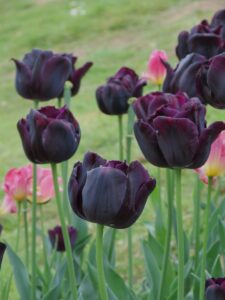
The cultivar name ‘Queen of Night’ aptly captures the regal and majestic quality of this tulip. The name reflects the deep, dark beauty that sets this tulip apart from other varieties. Black Tulips are often used as focal points in garden beds and borders, where their dark blooms create a stunning contrast with lighter-colored flowers and green foliage. They are also popular choices for cut flower arrangements, adding a touch of drama indoors.
Like other tulips, ‘Queen of Night’ is relatively easy to grow. They prefer well-drained soil and should be planted in the fall for spring blooms. Regular watering and proper care contribute to healthy plants and robust blooms.
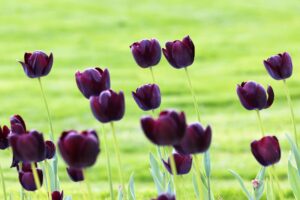
Petunia Black Color Flower (Petunia ‘Black Velvet’)
Petunia ‘Black Velvet’ is a captivating and unique flowering plant known for its deep, nearly black blossoms. Cultivating and growing this striking petunia variety requires attention to specific factors to ensure optimal development and a stunning display of dark blooms. Black Petunias, like other petunias, are typically grown as annuals. They are best planted in late spring or early summer when the threat of frost has passed, and temperatures are consistently warm.

Plant Black Petunias alongside other annuals with contrasting colors or as part of a monochromatic scheme. Combining them with silver or chartreuse foliage plants can create visually striking combinations. Cultivating Black Petunia ‘Black Velvet’ involves providing the right growing conditions, including ample sunlight, well-draining soil, and regular maintenance. With proper care, these dark and velvety blooms can add a touch of drama and sophistication to gardens, containers, and hanging baskets.
‘Black Velvet’ is a popular choice for various garden settings. Whether planted in containers, hanging baskets, or garden beds, its dark blooms create a stunning contrast against green foliage and lighter-colored flowers, contributing to an overall dramatic effect.

Black Calla Lily (Zantedeschia spp. ‘Black Star’)
The Black Calla Lily, scientifically known as Zantedeschia spp. ‘Black Star,’ is a mesmerizing flowering plant celebrated for its elegant and distinctive dark blooms. Zantedeschia spp. ‘Black Star’ is renowned for its striking, deep-purple to nearly black spathes, which are the modified leaves surrounding the central spike. The dark coloration creates a velvety texture, making it a unique and elegant addition to gardens.
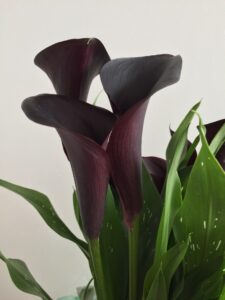
Black Calla Lilies typically bloom during the spring and summer months. The dark spathes, coupled with the characteristic yellow spadix at the center, create a visually appealing contrast that enhances their overall allure. While Black Calla Lilies are captivating, it’s important to note that they may be less readily available than traditional Calla Lily varieties. Their unique coloration and limited availability contribute to their desirability among enthusiasts.
Growing Black Calla Lilies in containers allows for greater flexibility in terms of placement and arrangement. Container-grown plants can be strategically positioned to showcase their dark blooms and create visual interest.
Iris Black Flower (Iris chrysographes)
Iris chrysographes, commonly known as the Black Iris or the Chinese Iris, is a captivating flowering plant celebrated for its deep, velvety blossoms and distinctive characteristics. The petals have a rich, dark hue that adds a sense of mystery and sophistication to the garden. Native to China, this iris species adds a touch of elegance and mystery to garden landscapes.
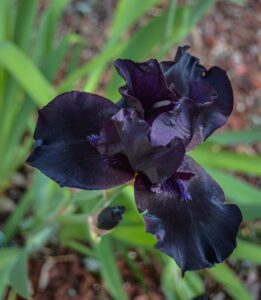
It is well-adapted to the diverse climates and elevations of its native habitat. Iris black color flowers thrive in well-draining soil and prefers locations with ample sunlight. While it can tolerate partial shade, providing full sun promotes vigorous growth and optimal flowering. Regular watering and proper soil drainage contribute to the overall health of the plant.
Black Iris can be strategically planted alongside other perennial flowers and ornamental grasses to create visually appealing combinations. Its dark blooms provide an excellent contrast to lighter-colored flowers, enhancing the overall design of the garden.

Pansy Black (Viola ‘Black Delight’)
Viola ‘Black Delight’ is renowned for its rich, dark, almost black flowers that resemble plush velvet. The deep coloration sets it apart from traditional pansies and adds a touch of elegance and mystery to garden landscapes.
Black Pansies are generally grown as cool-season annuals, thriving in cooler temperatures of spring and fall. The plant forms compact mounds with a profusion of dark black color flowers. Black Pansies prefer well-draining soil enriched with organic matter. They thrive in full to partial sunlight, making them versatile for various garden settings.

The bloom season for Black Pansies typically aligns with the cooler months of spring and fall. Its versatility, ease of cultivation, and unique coloration make it a popular choice for those seeking to introduce a dramatic and elegant element to their gardens.
Black Rose ‘Black Baccara’ rose
The concept of a true black rose, characterized by petals that are genuinely black, remains a fascination and symbol of mystery in the realm of floriculture. While nature does not produce roses with truly black petals, the quest for such a flower has led to the cultivation of varieties that exhibit deep, dark hues approaching black. One of the notable examples is the ‘Black Baccara’ rose.

The ‘Black Baccara’ rose is renowned for its velvety, dark red to almost black color flowers. The intense coloration of its petals creates a striking and captivating visual impact. The deep hue is often likened to the allure of true black, despite technically being a very dark red or maroon.
While a truly black rose remains elusive in nature, the allure and symbolism associated with varieties like the ‘Black Baccara’ contribute to their popularity. These roses capture the imagination and continue to be sought after for their unique and captivating aesthetics. Whether used in gardens, bouquets, or special occasions, the ‘Black Baccara’ rose adds a touch of mystery and romance to the world of flowers.

Black Hollyhock (Alcea rosea ‘Nigra’)
The Black Hollyhock, scientifically known as Alcea rosea ‘Nigra,’ is a captivating flowering plant celebrated for its majestic spires of nearly black blooms. Black Hollyhock ‘Nigra’ is a variety of the common hollyhock, prized for its distinctive flowers. The blossoms are a rich, dark hue that appears almost black, creating a striking contrast with the typical lighter shades found in other hollyhock varieties. Hollyhocks with black color flowers are known for their impressive height, typically reaching 5 to 7 feet (1.5 to 2 meters) tall. Their tall, erect stems are adorned with a vertical array of large, dark black color flowers, creating a majestic presence in the garden.
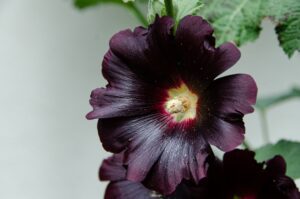
Black Dahlia (Dahlia ‘Black Satin’) Black Color Flowers
Dahlia ‘Black Satin’ is a cultivar known for its striking, deep-hued blossoms. The petals exhibit a velvety texture and a rich, dark color that appears almost black. This intense coloration sets it apart in the world of Dahlias.
The blooms of ‘Black Satin’ are characterized by their large, fully double flowers with layers of petals. The dark, almost black, petals create a dramatic and luxurious effect, making it a sought-after choice for gardens and floral arrangements. Like other Dahlia varieties, ‘Black Satin’ typically grows as a herbaceous perennial with a bushy habit. The plants produce sturdy stems that support the abundant and eye-catching flowers.
